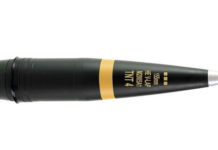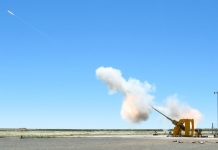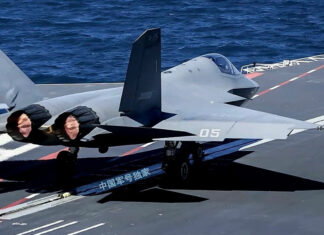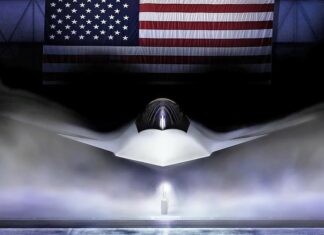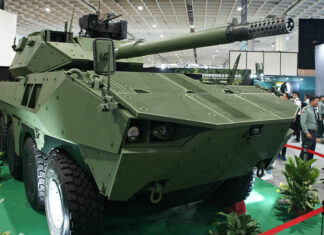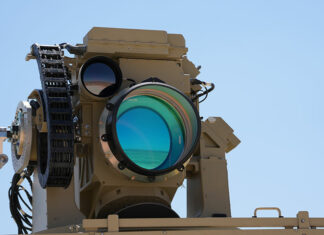The vertically launched missile high velocity IR homing missile was designed for all-round defense against simultaneous air attacks from multiple combat aircraft, helicopters and missiles. Up to eight targets can be engaged by the naval system. The truck mounted land based system is equipped with a quad missile group, fitted with all associated subsystems. The missile is fired according to targeting data provided by the system’s 3D radar. As the missile is launched, it flies to a lock-on point, using an on-board inertial navigation. At the designated point, the IR seeker is activated and the missile intercepts the target under seeker control. Throughout the flight, the missile is updated with the target’s course, via datalink. Umkhonto IR has a range of 12 km and ceiling of 30,000 feet. Intercept time from launch to impact at 9 km range is 16 seconds. An extended range version – Umkhonto-NG, is under development at Kentron. This version will be equipped with a rocket booster, and will employ an RF seeker head. In 2002 Umkhonto IR missiles were selected to equip six new patrol crafts of the Finnish Navy, as part of the new Haima class stealth fast attack crafts of Fleet 2000 program. The missile was also selected for the protection of the South African Navy Meko A-200 patrol corvetes.
Skunk Works and XTEND Simplify Multi-Drone Command
Tamir Eshel - 0
Lockheed Martin Skunk Works® and XTEND have achieved a major milestone in JADC2 by integrating the XOS operating system with the MDCX™ autonomy platform. This technical breakthrough enables a single operator to simultaneously command multiple drone classes, eliminating the friction of mission handoffs. From "marsupial" drone deployments to operating in GPS-denied environments, explore how this collaboration is abbreviating the data-to-decision timeline and redefining autonomous mission execution.
From Ukraine to Taiwan: The Global Race to Dominate the New Defense Tech Frontier
As traditional defense primes face mounting competition from agile “neoprimes” such as Anduril, Palantir and Helsing, the balance of innovation is shifting toward software-defined warfare and scalable, dual-use technologies, while global industry consolidation—marked by Boeing’s integration of Spirit AeroSystems and other strategic mergers—signals an intensified race to secure control over the defense technology value chain. Our Defense-Tech weekly report highlights these trends.
Europe’s “Drone Wall”
Tamir Eshel - 0
In early October 2025, a coordinated wave of unmanned aerial system (UAS) incursions—widely attributed to Russia—targeted critical infrastructure across at least ten European nations. The unprecedented campaign exposed the fragility of Europe’s air defenses...
Weekly Defense Update & Global Security Assessment
Tamir Eshel - 0
Executive Summary
The past week (September 18-25, 2025) represents an inflection point where strategic defense concepts have transitioned from doctrine to tangible reality. An analysis of global events reveals four primary, interconnected trends shaping an...
U.S. Air and Space Forces Push Next-Gen Programs at the AS&C 2025 Conference and...
Tamir Eshel - 0
At the 2025 Air, Space & Cyber Conference, U.S. Air Force and Space Force leaders unveiled major updates on next-generation fighters, bombers, unmanned systems, and space initiatives, highlighting both rapid innovation and critical readiness challenges as the services race to outpace global competitors. A short version is available here, with a more detailed version for subscribers.
TADTE 2025: Reflecting Taiwan’s Strategic Themes
Tamir Eshel - 0
The Taipei Aerospace & Defense Technology Exhibition (TADTE) 2025 crystallized around four dominant strategic themes that collectively illustrate Taiwan's comprehensive approach to defense modernization amid escalating regional tensions. Based on a detailed report by Pleronix (available upon request). Includes a Podcast discussion on TADTE 2025's highlighting Taiwan's four strategic themes beyond the post's coverage.
Iron Beam 450 Completes Testing, Soon to Join With Operational Air Defense Units
Tamir Eshel - 0
Israel’s Iron Beam 450 high-power laser system has completed final testing, marking a major leap in air defense. Developed by Rafael, it offers precise, cost-effective interception of rockets, UAVs, and mortars, and is set for IDF deployment by 2025.

